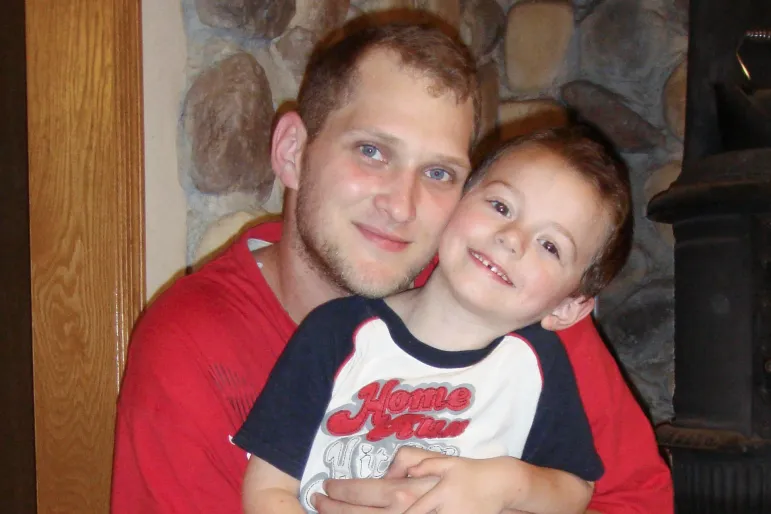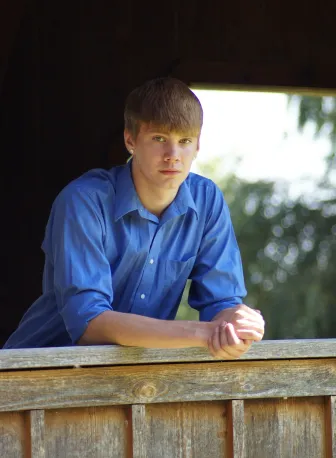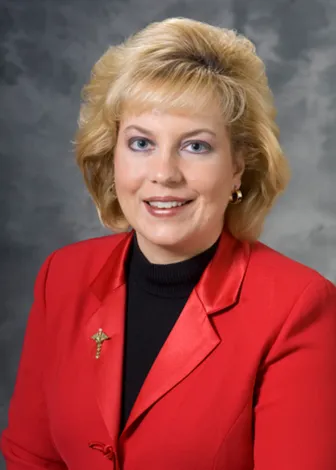This story was produced by Wisconsin Watch, a nonprofit, nonpartisan investigative reporting organization that focuses on government integrity and quality of life issues in Wisconsin.
- Download this story as a Word document
- Download the photos that accompany this story
- View the original story at WisconsinWatch.org
Dakota Black and Joshua Gehde are in prison for homicide after former UW Dr. Barbara Knox accused them of inflicting abusive head trauma.
By Brenda Wintrode, Wisconsin Watch
Nearly nine years after her son, Brayden, died, Shannon Turnbill still replays the image of the 5-year-old lying on the bed, unresponsive.

“It’s a picture I’ll never get out of my head,” she said of the encounter in October 2013. “His eyes were rolled back. It almost looked like he was having a seizure but not moving.”
After a University of Wisconsin doctor trained in identifying child abuse said Brayden had suffered from abusive head trauma, law enforcement blamed the only adult home with Brayden: Turnbill’s boyfriend, Dakota Black of Sun Prairie, Wisconsin.
In April 2016, Josh Gehde found his girlfriend’s 2-year-old daughter lying lifeless on the floor of their Madison, Wisconsin, apartment. Just minutes before, Gehde had given the toddler crackers and went to the bathroom to shave. When he came out, he saw chewed-up crackers on the rug near her face. He turned over her already cold body, struck her back to dislodge food and called 9-1-1.
The 9-1-1 operator coached him through CPR as he waited for paramedics. The girl died two days later after being removed from life support. Dr. Barbara Knox, the same UW child abuse pediatrician from Black’s case — who has been suspended and investigated by two hospitals in two states — said abusive head trauma caused the brain injuries that killed the girl.
Courts, legal experts and medical specialists are increasingly scrutinizing the abusive head trauma diagnosis, an umbrella term that includes the controversial diagnosis of shaken baby syndrome, for lacking a scientific basis and criteria for diagnosis. Earlier this year, a New Jersey judge labeled abusive head trauma “junk science” and refused to allow testimony about the diagnosis in his courtroom.
In both cases, Knox said the injuries happened within minutes of the child’s collapse, blaming the last person with the child. Records show that police and prosecutors, confident in Knox’s credentials, looked no further.
During each trial, attorneys and experts battled for the jury’s trust.
In the Gehde case, prosecutors showed jurors photos of a small, lifeless body still on life support, and in Black’s case, painted him as someone Brayden feared. Knox testified to a “reasonable degree of medical certainty” that each child died from abuse. Defense experts, who specialized in pediatric neurology and forensic neuropathology, blamed other possible conditions, saying they saw no signs of abuse.

“It would be most unusual to have a fatal head injury without an obvious large bruise on the scalp and a skull fracture,” Black’s expert, neuropathologist Dr. Jan Leestma, said in a report. “This child doesn’t have any of these things.”
But in the end, the juries in both cases believed Knox.
Black and Gehde are serving lengthy sentences in Wisconsin prisons, convicted of murdering the children in their care. They pleaded not guilty and refused prosecutors’ plea deals, despite facing decades behind bars. Both have lost their appeals.
The men insist they are innocent. Some family members of the children who died, including Turnbill, say they do not believe these men killed the children.
And Wisconsin Watch has identified at least eight cases in which Knox determined a child had suffered head trauma from abuse that investigators and medical specialists said were caused by benign medical conditions, injuries from severe birth trauma, accidental falls, a bleeding disorder and a possible stroke.
Knox did not respond to attempts to reach her for comment.
A national debate
These controversies are not unique to Wisconsin. In late April, a Texas appeals court halted the execution of Melissa Lucio, convicted of killing her 2-year-old daughter — a death the state’s medical examiner said was caused by “blunt force trauma” to the head in 2007.
Lucio and other family members had told police the girl fell down the stairs and was not abused — but then Lucio confessed to killing her after five hours of interrogation. The high court, citing several factors including Lucio’s possible innocence, sent the case back to a lower court for review.
Nationally, since 1992, 26 people have been exonerated following convictions on charges stemming from diagnoses of abusive head trauma or shaken baby syndrome, according to The National Registry of Exonerations.

The human instinct to protect children can snowball momentum around a child abuse allegation, making it “all too easy to sweep innocent people up in the process,” said Keith Findley, co-founder of the Wisconsin Innocence Project, who has written extensively about the problems of this type of diagnosis.
Knox’s fraught tenure
During her 13-year tenure in Wisconsin, Knox acted as a crucial liaison between the UW’s Child Protection Program and law enforcement, providing medical diagnoses, consultations or expert testimony in over 200 criminal cases, according to open records responses from 14 district attorneys in southern and central Wisconsin and an analysis of electronic court records by Court Data Technologies.
One of about 350 nationally certified child abuse pediatricians trained in recognizing child maltreatment and legal proceedings, Knox led the UW program until 2019, leaving after the hospital investigated whether she bullied her colleagues. Alaska CARES hired her that same year to lead the state’s forensic child abuse clinic. A joint investigation by Wisconsin Watch and the Anchorage Daily News found Knox generated similar allegations there.
During her brief tenure, the entire medical staff of Alaska CARES left or had their jobs reassigned. Knox submitted her resignation from Alaska CARES in January, scheduled to take effect on April 1. In March, online records show Knox was issued a medical license in Florida.
In all, the joint investigation also found 12 cases in which Knox’s diagnoses of abuse were rejected by juries, court officials, child welfare workers, investigators and other doctors.
Knox tied to 124 Dane County cases
But hundreds more cases funneled into the criminal justice system.
Dodge County District Attorney Kurt Klomberg said he stopped using Knox as an expert in 2017 after she failed to provide a timely report in an abusive head trauma case. He said he decided not to “support any child abuse or neglect cases for prosecution based on the work of Dr. Knox unless she had completed an opinion report prior to the decision to charge.”
Klomberg said he also advised law enforcement and human services to seek experts from other hospitals. After he made that decision, Klomberg got one referral for child neglect that Knox alleged. He declined to pursue it for lack of evidence.
“I seek to engage medical experts who I can rely upon,” Klomberg added. “I determined that I would not likely support a case involving Dr. Knox’s independent opinion several years ago.”
Juneau County District Attorney Kenneth Hamm said his office still has pending cases that originated on Knox’s medical opinions. After Knox left Wisconsin, he requested second opinions from other doctors, which Hamm said were “generally in line with what Dr. Knox stated and did not change the outcomes.” He added that none involved abusive head trauma or shaken baby syndrome.
Hamm and Portage County District Attorney Louis Molepske Jr. both told Wisconsin Watch they would consider re-examining closed cases if new evidence or concerns about Knox’s diagnoses emerge.
Of the 208 cases found by Wisconsin Watch, the Dane County District Attorney’s Office brought 124, over 70% of them since Ismael Ozanne’s election in 2010.
In an interview, Ozanne expressed confidence in convictions made by his office involving Knox’s diagnoses and said reviewing the cases because of questions about Knox’s job performance was an “oversimplification.”
“We were not just speaking with Dr. Knox alone,” Ozanne told Wisconsin Watch. “We were having to reach out to other experts . . . And, to my knowledge, none of those diagnoses were ever called into question. The hospital has never called us and said any of these diagnoses you should be worried about to my knowledge; and law enforcement has not reached out to us to say there’s other evidence that we have that basically shows that what was referred to you is false.”
Ozanne said he had not reached out to the UW to discuss possible misdiagnosis, adding, “I would assume if there were questions, they would reach out to us.”
Findley said the fact other doctors agreed with Knox “does not resolve the matter” because of the “repeated allegations and findings that Dr. Knox bullied colleagues” and that “plenty of other doctors and experts have raised concerns about some of her determinations.”
Findley described Knox as “an unusually aggressive and prolific advocate for concluding a child was the victim of abuse on vague, non-specific medical findings, which the research shows can have multiple etiologies, not just abuse.”
The hospital and law enforcement not alerting Ozanne to possible mistakes is “hardly surprising,” given the potential legal liability, Findley said. He added that Knox’s work history “ought at the very least prompt serious concerns about what wreckage she might have left in her wake in this jurisdiction,” he said.
Four witnesses noticed something off
The day Brayden Turnbill collapsed, his mother remembers her son waking up “happy.” She helped Brayden dress in one of his favorite superhero T-shirts and tied his shoes. The little boy who loved the Teenage Mutant Ninja Turtles and the Green Bay Packers had yet to master shoelaces.
Four people who saw Brayden after school that day told Sun Prairie police they noticed something off with the normally cheerful, fun-loving kindergartner. Two, who were children, described Brayden as looking “sad,” and as if he had been “crying without tears.”
Black said he repeatedly asked Brayden if he was OK after he came home from school with “bloodshot” eyes and acting “whiny.” Patricia Garwo, Turnbill’s cousin who picked Brayden and her children up from the bus that day, also asked him several times if he was alright, according to police reports.
The boy’s 5-year-old cousin told police that she twice saw Brayden fall on the playground. The following year an investigator for the defense reported more detail: “She said Brayden fell once off the gray monkey bars and landed on his knees, and fell once off the red monkey bars and landed on his feet . . . She said she saw with her own eyes that Brayden hurt his back, and almost his arm, on the big gray pole.” The girl said Brayden told the teacher supervising recess and went to the school nurse.
But the jurors who convicted Black never heard the girl’s testimony. Dane County Circuit Judge Stephen Ehlke barred details of the reported fall, ruling it irrelevant since she did not see Brayden hit his head.
Once he got home from school, Brayden visited a neighbor’s house briefly, played for about 15 minutes with his infant brother before telling Black he was tired and going downstairs for a nap.
Black told police he stayed upstairs with couple’s baby. The next time he saw Brayden was after Turnbill found him unresponsive in his bed.
Devastating news
As the mother of eight children, Turnbill saw some of Brayden’s older siblings experience fever-induced seizures when they were young. But when Brayden didn’t recover as her other children had, Turnbill yelled for Black to call 9-1-1. When she got on the phone, the operator walked her through CPR. And when she lifted his shirt she and Black saw a diagonal mark across his chest. Black said it looked like “he got hit with a stick.”
Doctors at St. Mary’s Hospital in Madison rushed Brayden by helicopter to the UW where doctors performed emergency brain surgery in an unsuccessful attempt to save his life. Turnbill followed with a friend to the UW.
Once there, Turnbill recalled how Knox delivered the devastating news: “We did what we could, but Brayden’s gone.” Turnbill remembered sliding off the chair to her knees and wailing.
Abuse was the only possible explanation for her son’s death. “ ‘Whoever was the last person with him is the one who did this.’ That’s exactly what she said,” Turnbill recalled.
Turnbill will never forget what Knox said next. Still standing over the grieving mother, the doctor said Brayden had bleeding on his brain “so severe that, that his, his brain pretty much fell into two pieces.”
Turnbill stammered as she recounted the episode almost nine years later, asking:
“How the hell are you going to come in and tell a mother that about her son?”
Police: ‘She has credentials’
After questioning Black at home for hours, police arrested him on an outstanding probation violation for a drug charge and took him to the Sun Prairie Police Department.
Detective Frank Smith ran the interrogation. He told Black he believed everything Knox told police — the boy’s collapse from a massive brain injury happened within minutes of being abused, according to a transcript.
“She’s an expert in her field,” Smith told Black. “She’s an expert witness for the state of Wisconsin. Okay? She has credentials.”
Then the officer added: “Something happened in the house. You did something to him.”
After Black denied harming Brayden — “I love that kid like he’s my own son” — the officer would have none of it.
“If I had any doubt or reserve of what she (Knox) told me, I wouldn’t be accusing you of doing this,” Smith said. “But I am because I believe her. I have that much faith in her science and her training.”
Black told Wisconsin Watch in a phone interview from Green Bay Correctional Institution that the interrogation was “intimidating” but “I wasn’t really scared, because . . . I didn’t have anything to hide.”
In court, Knox and pediatric radiologist Dr. Wilbur Smith testified for the state that the bruise across the boy’s chest looked to them like a “loop-mark injury” from someone striking him with a cord, like an extension cord or cell-phone charging cord. A police search of the home failed to find a cord fitting Knox’s description.
Ehlke’s ruling barring the testimony about falls on the playground kept defense experts from discussing how short falls can sometimes cause serious brain injuries in children, and in rare cases, death. In 12 of the 18 cases cited in that study, the children experienced a “lucid interval” of as long as two days before collapsing.
Knox acknowledged the possibility of lucidity between injury and collapse and referenced the 2009 death of actress Natasha Richardson, whose health declined hours after hitting her head in a skiing accident and died two days later.
Asked whether that could have happened in Brayden Turnbill’s case, Knox responded: “Absolutely not” — because their brain bleeds occurred within different, yet proximal, layers of the brain. However, a 2018 Medscape article reported that more than half of the patients who had the same type of bleeding as Brayden “had lucid intervals and were able to make conversation between the time of their injury and subsequent deterioration.”
Black was convicted after a nine-day trial in Dane County Circuit Court. Turnbill refused to testify for the prosecution. “I still believe that something happened to him at school,” she said.
Black, now 32, won’t get out of prison until 2045. Then, he faces 21 more years of community supervision, finishing his sentence at age 76.
‘It was the scariest thing ever’
Joshua Gehde said he never minded watching his girlfriend’s daughter, who he described as “very bubbly, happy, always smiling.”
The three had lived together for six months in an apartment near Madison’s Reindahl Park. They loved to visit the city’s botanical garden and just get outside together, he said.
“It felt like we were becoming a family, like everything was coming into place,” Gehde said during a phone interview from Stanley Correctional Institution.
On the morning the 2-year-old collapsed, his girlfriend went to work, and Gehde took the toddler to the park. He snapped a photo of the girl with a pacifier in her mouth, wisps of blond hair surrounding her face beneath the hood of her pink coat, and sent it to her mother.
After about an hour at the park, they went back home for lunch. He broke up some Ritz crackers on the highchair tray and put it on the floor where she could reach. He heard her cough a few times while he was in the bathroom but “didn’t think anything of it,” he told police. He thought she was fine. Minutes later, she wasn’t.
A paramedic who arrived at the scene said the girl’s lips were blue, and a firefighter reported using forceps to remove regurgitated food from her airway. A police officer who arrived on the scene originally concluded the event was a “tragic accident,” according to court documents.
Two days later, the girl died at the UW. Doctors reported the girl had brain and eye bleeding and brain swelling. Knox documented multiple bruises, including on the back of the girl’s head, and a large red mark on the girl’s left buttock she described as a “handprint.” Citing the brain and eye findings as a “constellation” of injuries, and marks she labeled as bruises, Knox declared the girl suffered “definite abusive head trauma.”
The day after the toddler died, Gehde, shackled at the wrists and ankles and wearing blue prison scrubs, shuffled into a Dane County Sheriff’s Office interrogation room. The then-25-year-old and two Madison police detectives sat on upholstered furniture, a coffee table between them, while he recounted the events leading up to the girl’s collapse.
At the request of detectives, he reenacted how he gave her back blows to dislodge the food from her throat on a toddler-sized mannequin.
“It was the scariest thing ever . . . she was lifeless,” he told the Madison detectives, as he sat back on the couch and reached for tissues to dry his eyes.
But detectives rejected his story based on what Knox told them. “We know for sure the doctors are going to say she didn’t choke on anything,” Detective Maya Krajcinovic said.
Since Gehde was the last one with her, he was the only one who could tell them what happened, they said.
“I’m not going to admit to something I didn’t do,” Gehde said, dissolving into tears. “I f***ing loved that girl.”
Later in the interview, Krajcinovic picked up the mannequin to demonstrate what she thought could cause the girl’s injuries. “If somebody grabs a kid and gets upset,” she said, shaking the dummy, its head flailing back and forth, then strikes its head on a couch, “ … that’s what causes bruises.”
Gehde looked at her confused and asked, “Who does that though?”
Defense offers other causes
Three medical specialists hired by the defense testified the girl died after blood clots in her brain caused a seizure, starving her brain and heart of oxygen. A neuroradiologist said small seizures can mimic a choking incident. And the girl’s autopsy report revealed she had bitten her tongue, a common occurrence in children having seizures.
Pediatric neurologist Dr. Joseph Scheller, said he could not determine if the clots were hours or days old. Regarding her bruises, he wrote 2-year-olds “can easily become bruised while engaging in play activities.”
In her medical report, Knox acknowledged the girl’s brain scan showed blood clots and bleeding throughout her brain, but, coupled with the child’s multiple bruises, concluded the girl’s brain injury was due to abusive head trauma.
During a cross-examination at trial, Gehde’s attorney asked Knox if she’s ever made a mistake.
“I am not aware that I have ever had a mistaken diagnosis,” she answered.
Gehde and other members of his family independently told Wisconsin Watch that the day after his defense team’s experts testified, some of the girl’s family members, including the child’s mother, switched sides and sat near Gehde’s parents and his defense attorneys.
If he had pleaded guilty, Gehde said both families would have “never heard any of this, they would have never heard the evidence to let them know I didn’t do anything — for them to support my innocence.”
The girl’s mother did not respond to interview requests, and attempts to interview other family members were unsuccessful. Private messages shared with Wisconsin Watch between the Gehde family and some of the girl’s family members, as recently as 2020, revealed they believed Gehde is innocent.
However, the jury did not.
Gehde’s 20-year prison sentence ends in 2039, followed by 15 years of probation. He unsuccessfully appealed in 2019.
He wrote in an email from prison: “My whole life was stripped from me for something I didn’t do.”
Separated — but still close
Less than one year after Brayden died, a consultant hired by the Sun Prairie School District inventoried the district’s playground equipment. The study listed — in poor condition and as a high priority for replacement — three district play structures, one of which was the monkey bars from which the girl said she saw Brayden fall.
A spokeswoman for the school district refused to answer questions about Brayden’s reported fall from the Royal Oaks Elementary School playground structure and the timing of the consultant’s hiring.
Black and Turnbill remain close and are trying to raise their two sons together, although the prison has banned her from visiting him because he was convicted of killing her son.
Black talks to his sons several times a week on Turnbill’s phone. The boys, who are now 9 and 8, know their father is in prison because of something that happened to their brother, but she has spared them the details.
She tells them, “The police don’t always tell the truth . . . the lawyers, the judges; the news doesn’t always tell you the truth.”
After Brayden died, Shannon and the boys lived with Black’s mother for three years, but have since moved from one living situation to the next. She now works as a housekeeper in a Madison hotel and rents a room there for her and the boys while she tries to get subsidized housing.
She hopes in sharing her story she can uncover the truth of what happened to her son that day — and find some justice for Black.
“Someday, I hope they figure out what really happened, and let him go.”
The Fund for Investigative Journalism provided financial support for this story. The nonprofit Wisconsin Watch (www.WisconsinWatch.org) collaborates with WPR, PBS Wisconsin, other news media and the University of Wisconsin-Madison School of Journalism and Mass Communication. All works created, published, posted or disseminated by Wisconsin Watch do not necessarily reflect the views or opinions of UW-Madison or any of its affiliates.


